
by Brian McCombie - Thursday, June 15, 2017

It’s a victory for hunting, albeit a small one. Yet, anytime a mainstream media icon like Newsweek reports positive things about hunting, hunters and the NRA Hunters’ Leadership Forum will take it as a “WIN!”
Recently, Newsweek published an article entitled, “Humans and Nature: Hunting Serves the Environment By Controlling Overpopulation, Study Shows.”
That study, recently published in the European Journal of Wildlife Research, clearly revealed that hunting is an effective means of controlling burgeoning wildlife populations. The research was conducted by scientists at the University of Barcelona, who examined hunting and its impact on wild boar populations in Spain.
It turns out that Spain—indeed, much of Europe—is coping with a boom in wild hog populations. Some locales are seeing up to 20 percent annual population increases, as well as the damage that comes from hordes of hungry, wild porkers—a situation all too familiar for people in many areas of the United States.
The researchers looked at wild hog hunting harvests in various parts of Spain before and after hunting bans were instituted. The data revealed that, once hunting was stopped, feral hogs numbers jumped precipitously. When hunting resumed, hog numbers leveled off noticeably and in some cases even decreased.
And if there were no hog hunting at all? The University of Barcelona researchers calculated that the number of feral hogs would have increased “exponentially.”
That hunting can keep wildlife populations under control isn’t really news to America’s hunters, especially our millions of deer hunters. A decade and more ago, large swaths of the East Coast, the Midwest and the South saw a dramatic increase in whitetail deer herds. Deer numbers were so high, farmers reported crop losses in the tens of millions of dollars. Deer-vehicle collisions were climbing to unacceptable levels. In some areas, deer were even stripping out native plants to the point that “browse lines” devoid of vegetation were very evident in wooded areas from the ground level to six feet or more up tree trunks.
The main method used by state wildlife agencies to get deer herds under control? More hunting. Specifically, more hunting leading to larger harvests of whitetail does. Fewer does mean fewer fawns, and several years of solid doe harvests can, in fact, drop deer numbers in a given area.
As a 2015 report by the Quality Deer Management Association (QDMA) explained, “The size of deer herds is largely driven by the annual antlerless harvest … . Obviously deer-vehicle collisions, predation, disease, severe weather and other factors play roles, but they are minor compared to the number of antlerless deer hunters.”
To encourage more antlerless hunting, state game agencies made more antlerless tags available. In some cases, these same agencies even added funding to food-bank collection operations so hunters would have a means to donate excess venison. It worked.
According to the QDMA report, “In the Northeast, nine of 12 states (75 percent) have more antlerless harvest opportunity today than a decade ago, and seven states (58 percent) have even more than five years ago… most Northeast states greatly expanded antlerless opportunities during the first half of the past decade and the majority continued that expansion during the past five years.” In the process, hunters helped lower and stabilize deer herds that appeared out of control in the Northeast, the Midwest and the South.
But hunters were important to another part of the equation here, too.
As Lindsay Thomas, QDMA’s director of communications noted, his group, “urges hunters to use local data collection to evaluate local deer density and habitat quality and make appropriate decisions about doe harvest. A state bag limit should be seen as a framework, not as a goal that's appropriate for every hunter. State agencies cannot manage at the property level like hunters can.”
E-mail your comments/questions about this site to:
[email protected]
